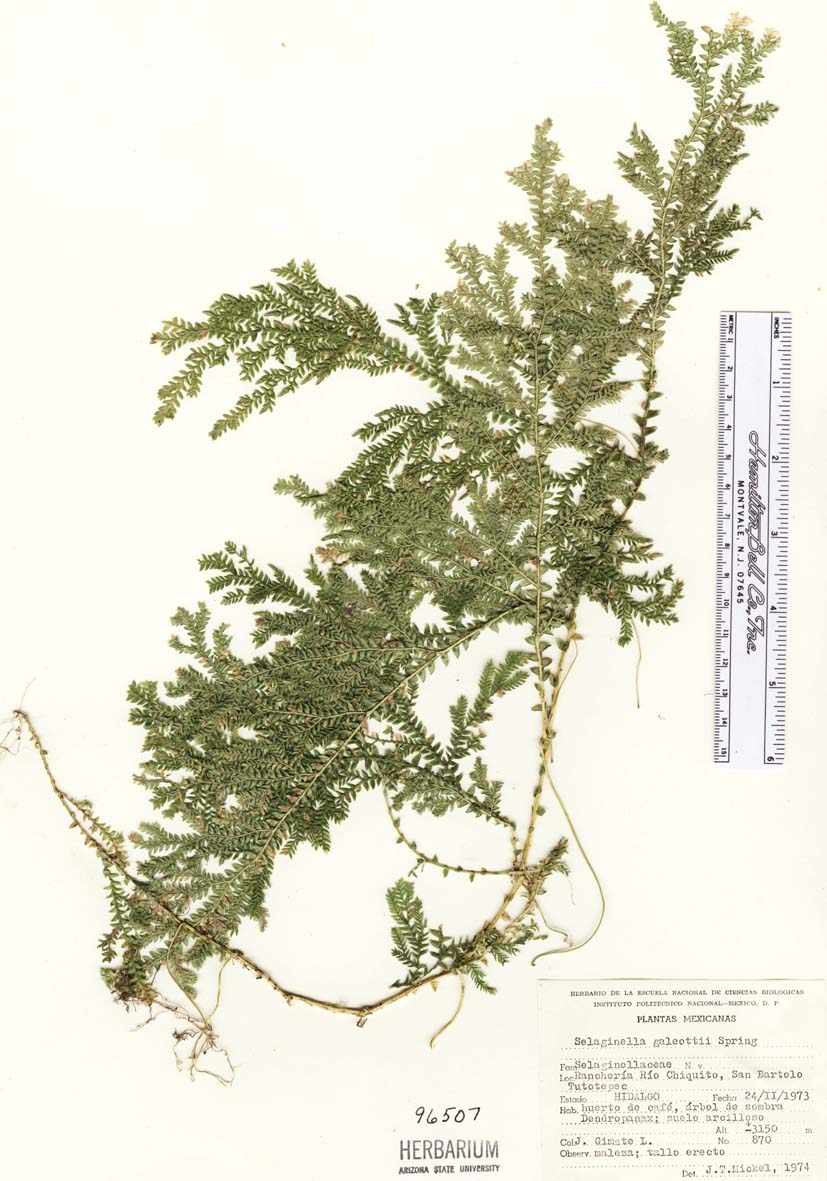Selaginella
|
Family: Selaginellaceae |
Plants terrestrial, on rock, or rarely hemiepiphytic (initially terrestrial, becoming epiphytic) or epiphytic (in S . oregana ). Stems prostrate, creeping, decumbent, cespitose, climbing, or fully erect, articulate or not, slightly to greatly branched. Rhizophores usually present, stout or filiform. Roots branching several times dichotomously from rhizophore tips. Leaves on aerial stems dimorphic or monomorphic; if monomorphic, then linear to narrowly lanceolate, highly overlapping, spirally arranged; if leaves on aerial stem dimorphic, then round or oblong to lanceolate, arranged in 4 ranks, 2 ranks of larger spreading lateral leaves and 2 ranks of smaller, appressed, and ascending median leaves, often with axillary leaf at base of each branching dichotomy. Megasporangia lobed to ovoid; microsporangia reniform to ovoid. Megaspores tetrahedral, ovoid, or globose, variously sculptured, (127--)200--1360 µm diam.; microspores tetrahedral, variously sculptured, 20--75 µm diam. x = 7, 8, 9, 10, 11, 12. The generic and infrageneric classification of Selaginella is controversial, and more than one genus may be recognized (see R. E. G. Pichi-Sermolli 1971 for information on generic synonyms). A. C. Jermy (1986, 1990b) proposed a subgeneric classification similar to that of J. G. Baker (1883, 1887). Despite some reservations, I consider Jermy's system useful for our purpose; therefore it is followed here. Three of the five subgenera proposed by Jermy occur in the flora area: subg. Selaginella , subg. Tetragonostachys , and subg. Stachygynandrum . One of the species in the flora, Selaginella eatonii (see discussion), may eventually prove to be best classified within a fourth, subg. Heterostachys Baker. Some characteristics used in the keys and descriptions are best observed in fresh specimens or by soaking a sample of a dried specimen in water, using material at branch forks or buds. This is particularly true for members of subg. Tetragonostachys . Use a minimum of 20X (40--60X better) magnification and take measurements of both young and old leaves. Measurements of leaf length include the bristle and the most basal portion. Selaginella subg. Tetragonostachys has a tendency for stem and leaves close to the substrate surface to be morphologically different from those on the side away from the substrate. In this case, the leaves on the side of the axis away from the surface are called upperside leaves , and those on the side toward the surface are called underside leaves . Otherwise, the leaves are designated only as leaves . In the subg. Stachygynandrum , however, which has complete structural differentiation between stem sides, the upper leaves are called median leaves , and the lower ones are called lateral leaves.
STEMS: (except in S. rupincola) not differentiated into rhizomes and aerial stems, branching dichotomously or more commonly pinnately, the branches sometimes dichotomously forked. RHIZOPHORES: produced from leaf axils on the adaxial side of the stem, elongate, slender, white to more frequently dark brown. LEAVES: sometimes dimorphic (those on the abaxial stem side sometimes larger and gray to tan or brown), appearing densely spirally arranged, narrowly elliptic to ovate, papery to somewhat hardened, tapered at the tip, the midvein usually noticeably ridged, sometimes extended into an awn-like or hair-like appendage (seta), the margins variously entire to ciliate. STROBILI: solitary on the branch tips, 4-ranked, the sporophylls differentiated from vegetative leaves, usually somewhat keeled and strongly folded around the sporangia, often slightly auriculate at the base. MEGASPORES: 0.2-1.3 mm in diameter. MICROSPORES: 30-75 mm in diameter. 700 NOTES: 750 species, nearly worldwide. (Diminutive form of ancient name “Selago” for a kind of club-moss [small Lycopodium]). The above description applies primarily to species of Selaginella subg. Tetragonostachys Jermy (ca. 50 species), to which all of the Arizona species belong. Taxa in this subgenus often are relatively difficult to determine, differing in small structural details. All of the Arizona taxa are hygroscopic, but some species, like S. arizonica and S. eremophila, have branch tips that curl inward with drought, whereas in others the leaves merely become more appressed and duller gray to brown. Terminal setae are best observed on leaves near the tips of vegetative branches on newer growth. Of the 5 currently accepted subgenera, 2 others occur in temperate North America. Subgenus Selaginella comprises only 2 species of northern North America and Hawaii that resemble certain kinds of diminutive clubmosses. The resurrection plants are a small group presently classified in the large, mostly tropical subg. Stachygynandrum (P. Beauv.) Baker, which is considered polyphyletic by some pteridologists (Korall & Kenrick 2002). There are persistent anecdotal reports that one of these species grows somewhere in southeastern most Arizona, but this has not been confirmed to date. The resurrection plants have the main stems densely cespitose and forming a dense rosette that curls inward during times of drought. Rhizophores are restricted to the basal portions of the stems. Two mainly Mexican species, S. lepidophylla (Hook. & Grev.) Spring and S. pilifera A. Braun, are found in southern New Mexico and adjacent Texas, and a third, S. novoleonensis Hieron., occurs from the mountains of central Sonora eastward. These should be searched for in eastern Cochise County on rocky slopes and exposed canyon walls. REFERENCES: Yatskievych, G. and M. D. Windham. 2009. Vascular Plants of Arizona: Selaginellaceae. CANOTIA 5 (1): 39-48. Terrestrial evergreen herbs superficially resembling mosses. 500, cosmop. Gleason, Henry A. & Cronquist, Arthur J. 1991. Manual of vascular plants of northeastern United States and adjacent Canada. lxxv + 910 pp. ©The New York Botanical Garden. All rights reserved. Used by permission. |

